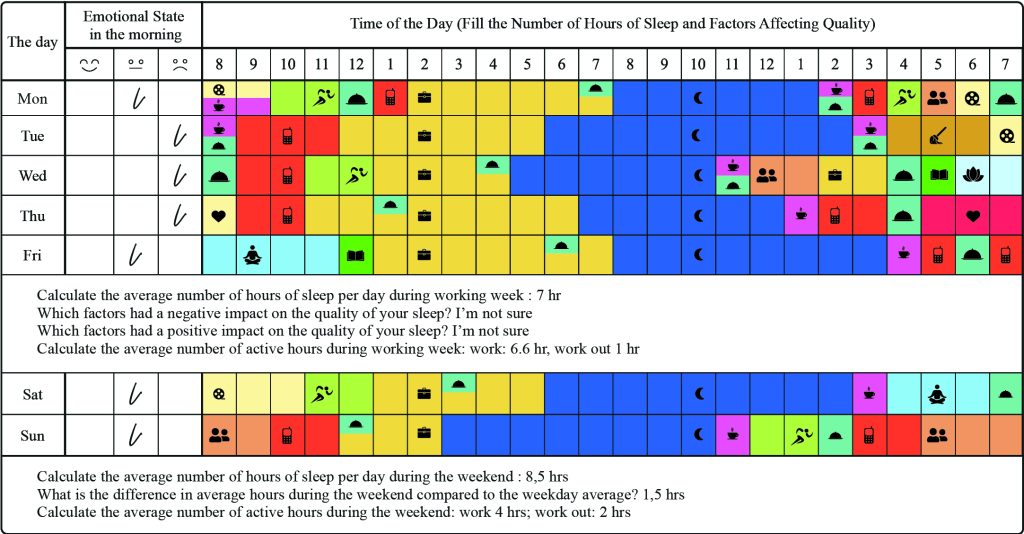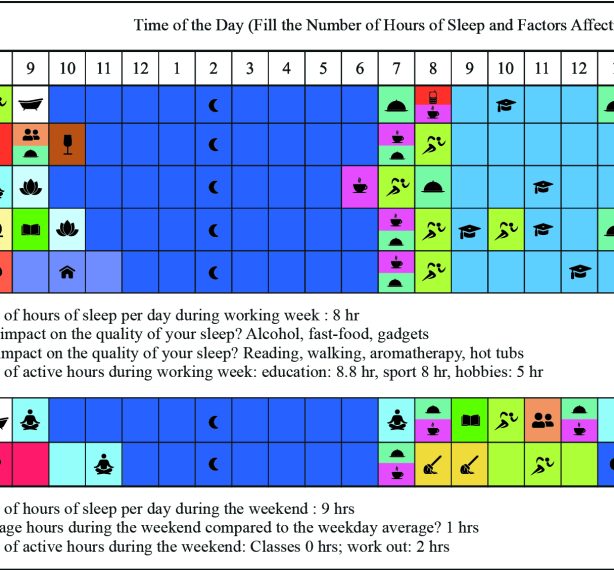
 – alcohol
– alcohol – work out (gym, walks, yoga, pilates, etc.)
– work out (gym, walks, yoga, pilates, etc.) – gadgets (social media, games, messengers, etc.)
– gadgets (social media, games, messengers, etc.) – coffee and energetic drinks
– coffee and energetic drinks – meals
– meals – work
– work – education
– education – reading
– reading – sleep
– sleep – family and friends
– family and friends – home
– home – tv
– tv – meditation and relax
– meditation and relax – hobby and other activities
– hobby and other activities – date, relationship
– date, relationship – chill
– chillSleep Patterns
This weekly tracker example shows a slight difference between the amount of sleep during the workweek (an average of 7 hours) and the weekends (an average of 8.5 hours). This indicates minor social jet lag, with the optimal amount of sleep for recovery being around 8 hours.
Determining Chronotype
This chronotype is a classic night type (owl). Night types experience a surge of energy and activity in the evening and nighttime. They usually don’t feel hungry in the morning and may feel sleepy and sluggish throughout the day. They prefer working and exercising in the evening and night, and their appetite typically increases in the evening, often leading to weight issues.
For this tracker example, the ideal wake-up time without an alarm is 11 AM, with bedtime no later than 3 AM.
Habits Affecting Sleep Quality
In this tracker, specific habits affecting sleep quality were not noted.
However, this example is based on a freelancer (software developer) who maintains a flexible work schedule and follows their genetic code.
Habits that worsen sleep quality and recovery include intense sport, gaming, gadget use, and eating right before bed. To improve sleep quality and energy levels, consider the following habits: exercise in the afternoon (4-5 hours after waking), a hearty breakfast in the morning, replacing coffee with matcha or black tea, and preferring herbal teas (chamomile or mint) in the evening. A relaxed evening with friends and family, walks before bed, and reading books are also beneficial.
Balance of Active Hours and Rest Hours (Including Weekend Rest)
In this example, the workweek is irregular, and there is no rest even on weekends. For such a work schedule, it would be beneficial to break up the weekend with three workdays followed by a recovery day in nature or the countryside to relieve the nervous system.
Seasonality and Region
This tracker uses typical indicators for the summer period in the European zone, where increased daylight hours lead to high productivity and efficiency. During periods of less active sunlight, this chronotype will tend to fall asleep earlier and may require more hours of recovery.



